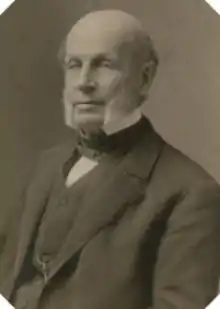Frederick Holbrook
Frederick Holbrook (February 15, 1813 – April 28, 1909) was an agriculturist, politician, and the 27th Governor of Vermont.
Frederick Holbrook | |
|---|---|
 Frederick Holbrook in 1901 | |
| 27th Governor of Vermont | |
| In office October 11, 1861 – October 9, 1863 | |
| Lieutenant | Levi Underwood Paul Dillingham |
| Preceded by | Erastus Fairbanks |
| Succeeded by | J. Gregory Smith |
| Member of the Vermont Senate from Windham County | |
| In office 1849–1850 Serving with Peter W. Dean, John Tufts | |
| Preceded by | John Kimball, Peter W. Dean, Larkin G. Mead |
| Succeeded by | Asa Wentworth Jr., John R. Blake, Ira Goodhue |
| Register of Probate for the Marlboro District | |
| In office 1848–1861 | |
| Preceded by | Broughton Harris |
| Succeeded by | R. W. Clarke |
| Personal details | |
| Born | February 15, 1813 East Windsor, Connecticut |
| Died | April 28, 1909 (aged 96) Brattleboro, Vermont |
| Political party | Republican |
| Spouse(s) | Harriet Goodhue |
| Parents | Sarah and John Holbrook |
| Profession | agriculturist / politician |
| Signature | |
Early life
Holbrook was born in East Windsor, Connecticut, son of Sarah and John Holbrook, a notable publisher and businessman. Via his mother's family, he was the grandson of Luke Knowlton. He attended Berkshire Gymnasium, Pittsfield, Massachusetts, for two years, then visited Europe in 1833. When he returned, he settled in Brattleboro, Vermont, where he engaged in agricultural pursuits.
Political career
He was elected register of probate for the district of Marlboro in 1847 and served until 1861. He represented Windham County in the Vermont Senate in 1849 and 1850, where, as chairman of a special committee on agriculture, he proposed to Congress the establishment of a national bureau of agriculture. He was a founder of the Vermont State Agricultural Association in 1850, and served as its president for eight years.
He ran as a Republican candidate for governor in 1861, and was elected by a large majority, 33,152 votes compared to 5,722 for his nearest competitor, Andrew Tracy. He was reelected in 1862, receiving 29,543 votes; his nearest competitor, Benjamin H. Smalley, received only 3,772 votes. In his second inaugural address, Governor Holbrook said "It is gratifying to realize that at each and every call of our country, in her hour of peril, thousands of the young men of our State have willingly and eagerly seized arms and have gone or are going forth to battle for the Union."[1]
Civil War
Governor Holbrook served as governor during what many consider the darkest days of the American Civil War. His administration saw the recruitment of 10 infantry regiments, 2 light artillery batteries, and 3 sharpshooter companies. Under his administration, as well, Vermont built three military hospitals in the state which were "soon credited by the United States medical inspector with perfecting a larger percentage of cures than any United States military hospital record elsewhere could show."[2]
Retirement
After his two terms as governor, he refused all further offers of public office, although he was diligently sought for a variety of positions. He returned to his farm and business interests, including serving as president of the Vermont Savings Bank. He was president of the board of trustees of the Vermont Asylum for the Insane for more than 40 years.
Death
He died in Brattleboro on April 28, 1909, and was buried at Prospect Hill Cemetery in Brattleboro.
Family
On January 13, 1835 Holbrook married to Harriet Goodhue, daughter of Joseph and Sarah Goodhue of Brattleboro. They were the parents of Franklin F. Holbrook, William C. Holbrook, and John Holbrook.
Legacy
The Deacon John Holbrook House built on Linden Street in Brattleboro by Holbrook's father still stands and is on the National Register of Historic Places.
See also
References
- Crockett, Walter Hill, Vermont The Green Mountain State, New York: The Century History Company, Inc., 1921, iii:522, 547-548
- Dodge, Prentiss C., compiler. Encyclopedia Vermont Biography, Burlington, VT: Ullery Publishing Company, 1912, p. 40.
- Ullery, Jacob G., Men of Vermont: An Illustrated Biographical History of Vermonters and Sons of Vermont, Brattleboro, VT: Transcript Publishing Company, 1894, Part II, pp. 198–200.
Notes
- Crockett, Walter Hill, Vermont The Green Mountain State, New York: The Century History Company, Inc., 1921, iii:522, 547-548
- Nancy E. Boone and Michael Sherman, "Designed to Cure: Civil War Hospitals in Vermont," Vermont History, Winter 2001, 69:174
| Party political offices | ||
|---|---|---|
| Preceded by Erastus Fairbanks |
Republican nominee for Governor of Vermont 1861, 1862 |
Succeeded by J. Gregory Smith |
| Political offices | ||
| Preceded by Erastus Fairbanks |
Governor of Vermont 1861–1863 |
Succeeded by J. Gregory Smith |

